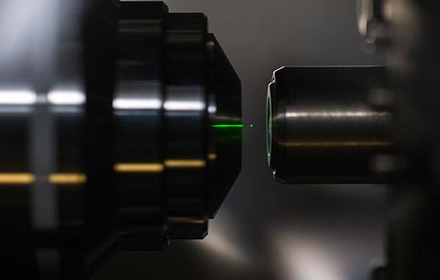
Levitated Optomechanics Could Lead to Advances in Sensing Technology
source:photonics
release:Nick
keywords: quantum sensing technologies; Laser trapping techniques; quantum mechanics
Time:2017-08-26

Levitated optomechanics can make a nanoparticle float in space. A finely focused laser beam forms an “optical tweezer” and creates a tiny, isolated laboratory for the study of delicate quantum states. Courtesy of J. Adam Fenster and Prof. A. N. Vamivakas/University of Rochester.
“Levitated optomechanical systems provide a clean platform for studying quantum optics, information science, and precision measurement and sensing,” said Mishkat Bhattacharya, an associate professor at RIT.
To explore different nanosystems, Bhattacharya isolated a nanodiamond in a pocket of light, suspending the particle in the laser light and effectively turning it into a floating probe. Bhattacharya is investigating the signatures carried in the light and the information it could reveal about the electromagnetic fields and the gravitational forces surrounding the nanoparticle.
The three-year study is supported by a $550,000 grant and is a continuation of a previous award. In the first study for ONR, the research team determined the smallest force that could be detected with a diamond crystal that levitated without spinning. The new study will explore the outcomes of three nanosystems, each using nanoparticles optically trapped under the following different conditions:
1. A particle containing an impurity which acts as a spin sensitive to magnetic fields or as an excess charge sensitive to electric fields;
2. A particle moving like a pendulum in three dimensions;
3. A particle larger than the wavelength of light entrapping it.
By exploring the interactions between light and tiny particles within the nano-realm, researchers hope to define a way to achieve more precise data capture within a cheaper, lighter sensor design. Sensing technology at the submicroscopic scale promises finer measurements of the physical properties that describe the world, such as electric and magnetic fields, temperature, force, velocity, acceleration and gravitation.
According to Bhattacharya, quantum sensors could someday detect gravitational waves, find dark matter and perfect quantum computing.
- RoboSense is to Produce the First Chinese Multi-beam LiDAR
- China is to Accelerate the Development of Laser Hardening Application
- Han’s Laser Buys Canadian Fiber Specialist CorActive
- SPI Lasers continues it expansion in China, appointing a dedicated Sales Director
- Laser Coating Removal Robot for Aircraft
 FISBA exhibits Customized Solutions for Minimally Invasive Medical Endoscopic Devices at COMPAMED in
FISBA exhibits Customized Solutions for Minimally Invasive Medical Endoscopic Devices at COMPAMED in New Active Alignment System for the Coupling of Photonic Structures to Fiber Arrays
New Active Alignment System for the Coupling of Photonic Structures to Fiber Arrays A new industrial compression module by Amplitude
A new industrial compression module by Amplitude Menhir Photonics Introduces the MENHIR-1550 The Industry's First Turnkey Femtosecond Laser of
Menhir Photonics Introduces the MENHIR-1550 The Industry's First Turnkey Femtosecond Laser of Shenzhen DNE Laser introduced new generation D-FAST cutting machine (12000 W)
more>>
Shenzhen DNE Laser introduced new generation D-FAST cutting machine (12000 W)
more>>
